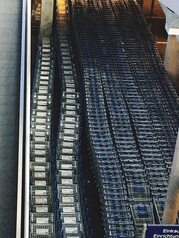Connectivity and Lifestyle: Driving Real Estate Appreciation

Connectivity has become a key factor in property valuation, transforming not only the urban landscape but also the lifestyles of those who inhabit them. In a world where access to the internet and transportation networks are essential, location stands out as a determinant for boosting real estate value. This article explores how the interconnection between these elements can be your best ally when investing in real estate, ensuring not only a smart purchase but also an enriched lifestyle.
The importance of connectivity in the real estate market
Connectivity in the real estate market has become a fundamental pillar for decision-making among buyers and homeowners. Easy access to high-speed internet services, as well as proximity to public transport lines, not only improves the quality of life for residents but also elevates the perceived value of a property. People are increasingly seeking environments that offer them comfort and efficiency, facilitating their remote work or daily commutes. In this context, a well-connected location translates into superior appeal for potential tenants or buyers, resulting in a significant increase in property value.
Additionally, connectivity also has deep implications for the social and economic dynamics of communities. Neighborhoods with good digital infrastructure and access to transportation tend to foster a more collaborative and active environment, where residents can engage in community activities and enjoy greater cultural diversity. This not only improves the overall well-being of the neighborhood but also establishes favorable conditions for local business development. Investing in properties strategically located within these connected areas thus becomes a smart decision that can generate sustainable long-term returns, both in financial terms and in quality of life for its inhabitants.
2. How does access to the internet influence added value?
Internet access has revolutionized the way we live and work, becoming an essential component for determining the value of a property. Homes located in areas with high-speed connections tend to be more attractive to both buyers and renters, resulting in increased demand and, consequently, a rise in real estate appreciation. People are increasingly looking for spaces where they can work from home, enjoy online entertainment, and access digital services without interruptions. This search for connectivity not only enhances the appeal of properties but also generates a positive effect on their valuation. Moreover, the availability of internet influences other aspects related to quality of life. Areas with good connectivity often have a more developed urban ecosystem, including stores, restaurants, and professional services that complement the modern lifestyle. This not only increases convenience for residents but also creates a conducive environment for local economic growth. When properties are situated in communities that offer robust digital infrastructure along with nearby amenities, their appreciation tends to increase significantly due to the widespread perception of added value by the real estate market.
3. Public transportation: A pillar to increase property value
Public transportation plays a fundamental role in property valuation, as it significantly improves accessibility and mobility within a city. A good transportation network not only facilitates the daily commuting of residents to their workplaces, schools, and recreational areas, but also connects different neighborhoods and communities, creating a more cohesive environment. Properties located near subway stations, bus stops, or trams tend to be more attractive to potential buyers and renters, resulting in a notable increase in their value. The ease of accessing various parts of the city can transform an area previously considered peripheral into a desirable place to live.
Additionally, the development and improvement of public transportation are often accompanied by investments in urban infrastructure and public services, which further contributes to the increase in real estate value. Areas that receive new lines or service improvements tend to see growth in housing demand, as residents seek to benefit from these amenities. Likewise, this type of connectivity encourages a more sustainable lifestyle by reducing dependence on private cars, thus promoting more eco-friendly options like walking or using bicycles. Consequently, investing in properties strategically located near public transportation not only ensures an excellent long-term financial option but also a superior quality of life for its residents.
4. Urban vs rural areas: Where is the best connectivity?
In the debate about connectivity, urban areas often take the lead, offering a wide range of options in terms of high-speed internet access and efficient public transportation. Cities are designed to facilitate mobility, with subway stations, buses, and bike lanes that allow residents to move around easily. This infrastructure not only improves access to essential services but also promotes an active and socially connected lifestyle. Furthermore, in urban environments, technology companies tend to establish themselves near these hubs, which further increases job opportunities and real estate demand.
On the other hand, rural areas have begun to close this gap thanks to technological advances and the increase in remote work. More and more people are looking to escape the urban hustle and enjoy a quieter lifestyle without sacrificing their digital connection. The development of wireless and satellite networks has allowed many rural areas to improve their connectivity, enabling their inhabitants to access fast and reliable internet. This not only attracts new residents who value both peace and digital access, but also boosts local economic growth by allowing emerging businesses to flourish in less saturated environments. The choice between living in an urban or rural area will increasingly depend on how that connectivity is valued in relation to the desired lifestyle.
5. The impact of remote work on housing preferences
Telecommuting has revolutionized the housing preferences of many people, leading to a significant change in how the location of a home is valued. Traditional offices have been replaced by home workspaces, allowing individuals to seek properties in less urbanized and quieter areas. This new flexibility has led many to prioritize features such as home comfort, access to green spaces, and friendly communities, sidelining the need to be close to the financial or business center. As a result, properties in suburbs or rural areas have seen an increase in demand and value.
Likewise, the impact of remote work has also reconfigured the understanding of connectivity. It is no longer just about having fast internet access; it is now essential to have an infrastructure that allows for a balanced lifestyle. Buyers are looking for homes that offer not only good digital connections but also proximity to essential services such as supermarkets, hospitals, and schools. This trend has led real estate developers to rethink their projects, integrating multifunctional spaces that promote both work and leisure, which further contributes to the value of these properties in an increasingly competitive market.
6. Sustainable urban projects and their effect on real estate valuation
Sustainable urban projects are redefining the real estate landscape by introducing practices that not only seek economic profitability but also improve the quality of life in cities. By integrating green spaces, promoting the use of renewable energies, and facilitating efficient public transport, these initiatives create more livable and attractive environments for residents. Real estate valuation benefits directly, as buyers and investors are increasingly interested in properties located in areas that prioritize sustainability and community well-being. Thus, a sustainable urban project not only elevates the value of surrounding properties but also fosters a sense of belonging and connection among its inhabitants.
Furthermore, the implementation of these projects can positively influence the perception of the area as a desirable destination. Developers who opt for eco-friendly and accessible designs contribute to creating a positive image of the neighborhood, which can result in a higher demand for housing. Statistics have shown that properties near parks, bike paths, and efficient public services tend to maintain or increase their value more quickly compared to those located in less environmentally friendly areas. In this sense, investing in real estate within sustainable urban contexts is not only beneficial from a financial perspective but also promotes a more balanced and healthy lifestyle for its residents.
7. Technological trends that enhance the appeal of a location
Technological trends have revolutionized the way we perceive and live in our homes, making certain locations particularly attractive to buyers. The implementation of smart technologies, such as home automation systems that allow remote control of lighting, heating, and security, not only enhances quality of life but also increases property value. Areas where these innovations are common tend to attract a younger, professional audience seeking comfort and efficiency in their daily lives. Furthermore, high-speed internet connectivity has become an essential requirement for many, facilitating remote work and enabling a more flexible lifestyle.
On the other hand, the creation of interconnected community spaces through mobile applications is transforming social dynamics within communities. The ability to access nearby services, such as optimized public transportation or digitally managed recreational areas, adds an extra level to the area's appeal. These features not only encourage greater social interaction among residents but also promote a sense of belonging. Consequently, real estate investors must pay attention to these emerging technological aspects when evaluating potential locations to ensure a solid investment that aligns with current market demands.
8. Strategies to enhance property value through connectivity
To enhance the value of a property through connectivity, it is essential to evaluate and promote the infrastructures that improve access to services and daily activities. This includes proximity to public transportation stations, such as metro or buses, as well as the availability of bike lanes and safe pedestrian routes. Fostering an environment where residents can easily move around not only improves their quality of life but also increases the appeal of the property for future buyers or renters. The creation of interconnected public spaces, such as parks and squares that facilitate social gatherings and recreational activities, can be another decisive factor in this process.
Another key aspect to increase added value is to ensure that properties have access to high-speed internet. In an increasingly digitized world, connectivity is not limited to physical transport; it also encompasses access to modern technologies. Properties located in areas where advanced services are offered, such as fiber optics or 5G networks, become very desirable options for telecommuters and young families. Additionally, by integrating smart technology solutions within the home, such as connected security systems or efficient home automation, the perceived value of the property can be further elevated. This way, not only is a broader profile of tenants or potential buyers attracted, but its position in the real estate market is also strengthened.



